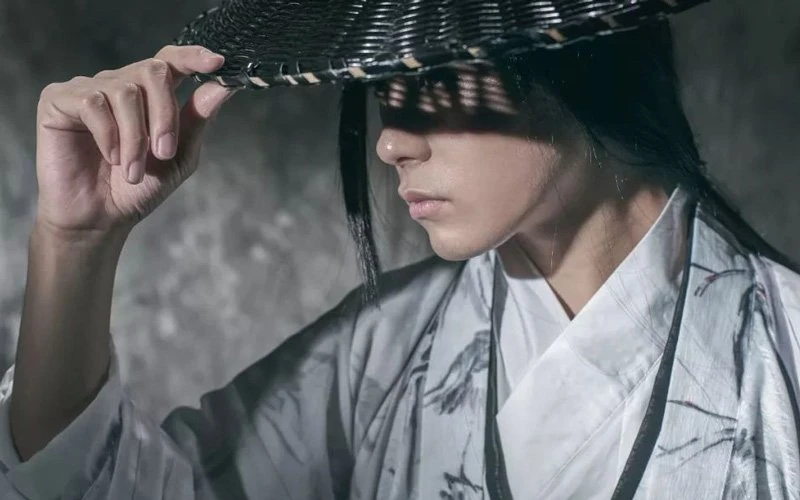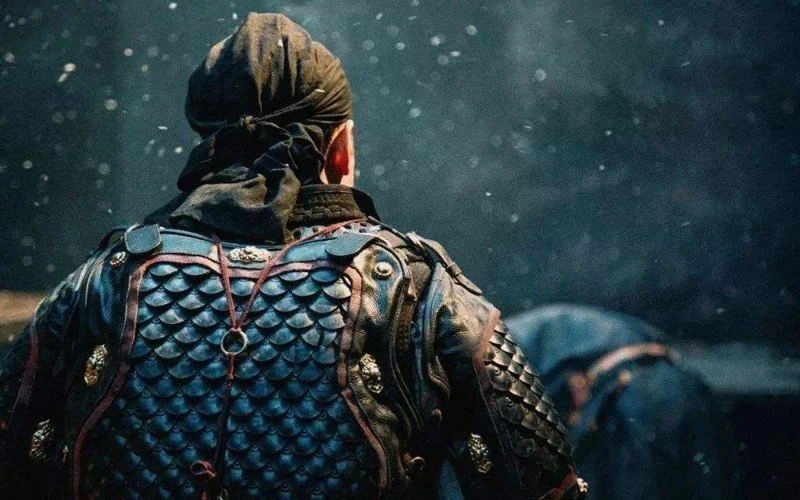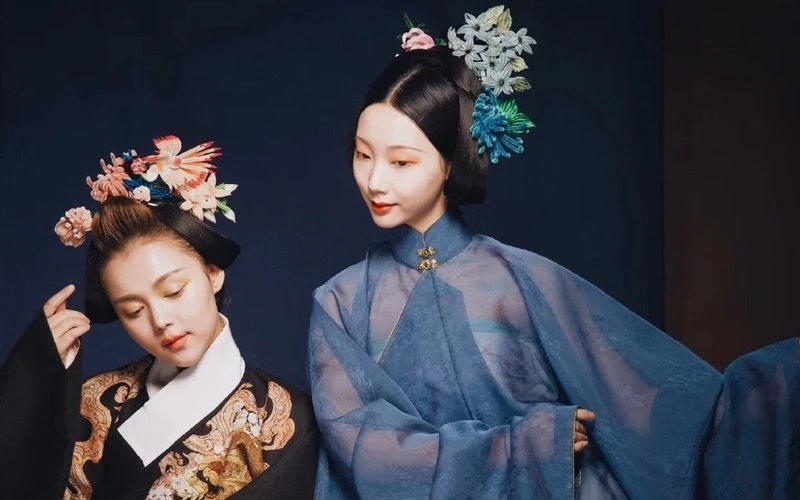Article
搜索结果:
-
How Beautiful is Blue Hanfu in Traditional Chinese Hanfu?
As one of the aspects of human civilization, the color culture in traditional Chinese Hanfu costumes has a long and splendid history. The color of clothing is often a symbol of the times and has strong political significance, and is closely related to the "five colors" that prevailed at that time. Today, we will lead you to have a deeper understanding of the "blue Hanfu". The Meaning and Place of Blue in Ancient Color Culture The so-called " Five Pure Colors" originates from the five elements, which are metal, wood, water, fire, and earth, and represent the five pure colors of blue, red, yellow, white, and black in the five directions of east, south, middle, west, and north. According to I Ching, black is the color of the sky and yellow is the color of the earth, which is why it is said that "the sky is dark blue and the earth is yellow".In addition, The Book of Rites recorded that in ancient times, the pure color was considered noble, and the color that combined two primary colors were considered inferior, and the pureness of clothing was highly valued. Blue in the five elements corresponds to the Eastern wood,… -
2020 Hanfu Model Contest National Finals held in Xuzhou
The 2020 "Liyi Huaxia (礼衣华夏)" Hanfu Model Contest lasted for more than 4 months, covering 76 cities in five regions, with 468 Hanfu associations and more than 6,200 contestants actively participating. The aim of the competition was to recreate the splendor of Chinese costumes and promote Chinese etiquette through the visible, wearable, and popular carrier of Hanfu. After three rounds of competition, 80 finalists from various regions were selected and the top 10 were born in Xuzhou. Xuzhou, located in Jiangsu province, has many historical and cultural treasures such as the Han tomb of Guishan, the mausoleum of the King of Gefengtai, and the Chinese pictorial stone, etc. In recent years, Xuzhou is committed to the inheritance and promotion of Chinese culture, transforms and develops creatively the symbols of Chinese culture such as Hanfu, Han rituals, Han music, and Han dance. The culture of Hanfu is gradually integrating into the life of ordinary people and is closely related to the cultural construction of the city. It is for this reason that the final of this popular national competition is held in Xuzhou. The finals are divided into three rounds: grooming, self-selected style, and stochastic expressivity. In the first round, 80… -
History of Chinese Embroidery Patterns & Apply in Hanfu Style
Chinese embroidery patterns are an excellent traditional Chinese craft with a long history, while Hanfu is a traditional Chinese costume, the two have a lot of combination, and many Hanfu styles applies delicate embroidery patterns. History of Chinese Embroidery Patterns & Lucky Patterns Embroidery (刺绣), known as needlework in ancient times, is one of the oldest Chinese handicrafts and has been around for over 2000 years. With the use of silk, the production and development of silk fabrics, embroidery has also gradually emerged, according to the "Shang Shu (尚书)" 4,000 years ago, the costume management system, it is stipulated that "the upper and lower garments are embroidered and painted". Chinese embroidery patterns reached its peak during the Ming and Qing dynasties, after being passed down for thousands of years. The techniques of folk embroidery and the materials used for silk embroidery both developed phenomenally. A large number of embroidery subjects in the Ming and Qing dynasties were auspicious motifs with Chinese characteristics, the so-called "picture must be meaning, meaning must be auspicious". There are hundreds of auspicious motifs in China, too many to mention. For example, mandarin ducks symbolize the love between husband and wife, pomegranate symbolizes many children, pine,… -
Hanfu Sewing Pattern (1) - Pifeng Cutting Diagram & Making
Diy crafting is a lot of fun, and not only can you be fully engaged in the process, but it's also very rewarding to finish a piece with your own hands. The same goes for making your own Hanfu, which is why we've launched this series, will continue to update the Hanfu sewing pattern and process of making different styles of Hanfu for you in the future. Introduction to Pifeng Hanfu Pifeng(披风, cape) is a form of Chinese Hanfu clothing, mostly straight-necked, Duijin (对襟), with two long sleeves, with slits under both armpits, can be worn both indoors and outdoors. From many portraits as well as notes on the data, Pifeng used to be a popular clothing style of the Ming Dynasty. Sewing Pattern Explained - Making Cuts Tutorial The Pifeng shape is not complicated, and those who like to make Hanfu or DIY Hanfu dress can try to make it if have the right fabric. Overall: A/B/C/D equal width, 50~60cm Cuff width 30-60cm (depending on sleeve size) Width of sleeve heel 30~40cm The collar is opened to the level of the armpit, and the width of the collar opening is twice as wide as the width of… -
4 Types of Chinese Architecture That You Need to Know
The Chinese have used the same architectural model for their imperial and religious buildings for more than two thousand years. It consists of three elements: a platform, a framework of pillars and beams, and non-load-bearing walls. The buildings usually incorporate the main gate, rectangular enclosures or courtyards, and a series of pavilions arranged in a line and facing north. Almost all buildings were constructed of wood, but due to vulnerability to fire very few survive; the oldest date from the Tang period. Here are some representative Chinese architectures. Pavilions The structure of the pavilions is always the same. They consist of a platform of rammed earth or stone and a grid of wooden pillars. The front part always incorporates an odd number of intercolumns. The meeting of pillars and beams is fixed with brackets (dougong), which support the structure and allow for overhanging roofs. The wood is lacquered in intense tones, and the roofs are curved, of tile or thatch. Plant building and plant pavilion Even before pagodas, multi-storey buildings (lou) were built in China, ranging from two-storey private residences to towering gazebos. The plant pavilions (ge) were used for storage and had only doors and windows at the front.… -
East Meets West - Hanfu Mix-Match Dressing Tips
With the trend of Hanfu, more and more girls are joining the Hanfu camp, but with the appearance of Hanfu homogenization, many girls are no longer satisfied with the current Hanfu wear, began to mix-match, mixing different elements together (for example, modern fashion elements and classic elements), look fashionable and generous. 1. What is "Western" and "Eastern" mixing? What is a mix of "Western" and "Eastern"? This is what we call "East meets West" style, just like the modified cheongsam, which combines Western modern elements with Chinese classical elegance, that is, East meets West style. The model in the picture is the extreme use of this style, grasping the essence, the Chinese Hanfu horse-face with Western-style hat and lace gloves combined with the wearing, actually has a different kind of elegant debutante style, compared to the traditional Chinese clothing collocation, appears more daily and modern. 2. How to mix-match to give more points to the overall image? ①How to choose Hanfu style? Due to the profoundness of Chinese culture, there are many different types of Hanfu, such as Tang, Song, Ming, etc. However, in order to better combine with the fashion elements, it is often better to choose the plain… -
How Much Do You Know About China's Teachers Day
Today (September 10) is China's teacher's day. Teacher's day has a very long history in China. Let's get to know it. History of China's Teacher's Day In ancient times, Teachers' Day had a great deal to do with Confucius. During the Han and Jin dynasties, on the birthday of Confucius (August 27th in the lunar calendar), the emperor would lead civil and military officials to worship at the Confucius Temple, and would also treat teachers to a meal. During the Tang and Song dynasties, the National Capital and all the states, prefectures and counties would hold festivals to celebrate the birthday of Confucius on this day, and the festivals were very grand. In addition, the State Children's College, the academy, the state, the government, and the county would also select those with outstanding achievements as "Siye (司业)" and submit them to the imperial court, and these "advanced educators" were rewarded with up to 500 taels of silver. In the Qing dynasty, the size and scope of the Confucius' birthday ceremony grew larger and larger, and the most accomplished teachers were given official positions on this day. The Meaning of "Teacher" "Teacher" initially refers to the old senior scholars or teaching… -
Unlock Many Ways to Wear a Beautiful Chinese Costume
The new term begins and we can finally bring our favorite Chinese costumes to school! But before that, you need to think about it: can you really fit that many Chinese costumes in your dorm wardrobe? Most student Chinese costume enthusiasts should have very limited wardrobe space in their dorm, so instead of bringing more than a few pieces, it's better to bring only the best ones to wear. With the right mix and match, you can wear something different every day! Today, we're going to unlock with you the super simple, guaranteed never-fail rule of wearing Chinese costumes! Beizi, Shanzi = Perfect Early Fall Chinese Costume Jacket Beizi and Shanzi are perfect for early autumn Hanfu jackets: Beizi' is just the right length to cover the lower half of the body and perfectly flatters the figure; long Shanzi can be used as a sun-protective shirt or air conditioner shirt, making it a great choice for early autumn; short Shanzi can be used as a playful jacket and can be knotted at the hem like a shirt, showing off the waistline! Tips: Beizi, which has a fancy edge, and Shanzi, which has a lot of embroideries, should be paired with… -
4 Sets of Hanfu Suits for Autumn - Elegant & Gorgeous
This summer is all about Song style Hanfu suits, which is both classic and fresh. But now it has slowly entered the autumn, it is also time to change the Chinese clothes in the wardrobe into more stable and atmospheric Ming Dynasty Hanfu. Ming-style Hanfu suits is a kind of shape for autumn and winter. Wearing it can set off people's dignity. For younger girls, you can choose a more playful style of Ming Hanfu, like this pairing of a short Ao (袄) with pipa sleeves and a horse-faced skirt, with a green short Ao embroidered with exquisite osmanthus flowers and jade rabbits. And the lower half, the horse-face skirt is also the same embroidery pattern, the fabric of this horse face skirt is also very light yarn fabric, this kind of fabric is more girly than ordinary fabric. Since the embroidery theme is a jade rabbit, plus it is a thicker Ming Hanfu, this set is perfect for the Mid-Autumn Festival. Although the style of this set is relatively fresh in Ming Hanfu, the overall look is still much more dignified than the standard Hanfu style. *What is the Pipa sleeve? The pipa sleeve is a type of sleeve,… -
How to Wear Hanfu (5) – Hanfu Vests: Bijia
Have you noticed the weather doesn’t cool down right away when the fall season starts? It’s a phenomenon sometimes referred to as the “Indian summer” if you live in North America, or "old women's summer" if you live in Europe, and in China, people call it “Autumn Tiger”. It can get really hot during the day but quite chilly at night, so this is a time when people can catch a cold easily. In ancient China, there’s a history of people wearing vests to keep warm during this time of the year, it was believed that the vest was first developed around 2,000 years ago, and later doubled as a fashion statement as time went on. Now let’s take a look at the history of this hanfu and How to wear it. The history of Hanfu vest Short sleeves or sleeveless garments have been around for a long time. The earliest artifacts found in China were from the Warring States Period (475–221 BC). During the Han Dynasty, the terms were coined in one of the oldest dictionaries - The Shiming or "Explanation of Names", sleeveless vests were called Liang Dang (裲裆), half sleeves were called Ban Xiu(半袖) or Xiu… -
Modern Complex of Ancient Chinese Traditional Clothing
I don't know if you've noticed, but in recent years, the number of people wearing ancient Chinese traditional clothing (Hanfu) has increased. There are people walking around the city center in ancient Chinese traditional clothing, people traveling in scenic spots, and even classrooms are full of them. CNN, Reuters, and other media outlets have reported on this Hanfu craze. Hanfu, meaning “Han clothing,” is based on the idea of donning costumes worn in bygone eras by China’s Han ethnic group. Some of the most popular styles are from the Ming, Song, and Tang dynasties. About three-quarters of Hanfu customers are between 16 and 24 years old. Members of this generation often see it as a way to rediscover and engage with their country’s traditional culture. There are also many styles of Han clothing. Its main elements include belts, intricately designed collars, and more. The main features of Hanfu include collars, upper garments in the style of a skirt, jade ornaments, and a sash, according to Wen Run, professor of textile design and industrial economics at Donghua University. Materials such as brocade and yarn, along with traditional craftwork, including embroidery, are also hallmarks of the attire. Chinese Han Clothing Makes A… -
12 Most Beautiful Traditional Chinese Wedding Dresses
Today is the traditional Chinese Valentine's Day, it's time to pick a beautiful traditional Chinese wedding dress for this important moment in our life. Every year on the seventh day of the seventh month of the lunar calendar, the Double-Seventh-Festival (the Chinese equivalent of Valentine's Day) is a traditional Chinese festival. According to folklore, the weaving girl Cowherd magpie bridge meeting, girls will be placed in the night seasonal melons and fruits, looking at the moon to worship, begging to give the intelligent mind and dexterous hands, but also begging for love marriage fate coincidence match. In modern times, it has gradually evolved into a festival for men and women to confess their love for each other, and many people even get married in Double-Seventh-Festival, making Double-Seventh-Festival their love anniversary. Of course, if you're single, don't go away, Double-Seventh-Festival will help you find your soul mate by the light of the lanterns by wearing a red Chinese costume, which is even more beautiful. Traditional Chinese Wedding Dress for the Double-Seventh-Festival Embroidery Qiyao Traditional Chinese Wedding Dress A wide variety of embroidery is in full bloom on the red traditional Chinese wedding dress. The soft dark red fabric, with… -
2020 Li Yi Hua Xia Hanfu Supermodel Competition
The full name of Hanfu is "traditional Han clothing", also known as Han Clothes, Han Costume and Chinese Dress, which were worn from Emperor Huang's reign to the middle of the 17th century (late Ming and early Qing dynasties). It is the embodiment of China's "Clothes on the Crown" and "State of Manners", and carries the outstanding craftsmanship and aesthetics of the Han nationality, such as dyeing, weaving, and embroidery, and has inherited more than 30 Chinese intangible cultural heritages and protected Chinese arts and crafts. Hanfu Supermodel Competition Inaugurate On August 8, 2020, on the occasion of the state celebration of Qiannan, the Duyun Hanfu Model Competition will be held. Hanfu Supermodel Competition Highlights According to the Records of the Grand Historian of China, "Ancient Chinese clothing was made by the Yellow Emperor" and "Before the Yellow Emperor, there were no clothes and houses. And the Yellow Emperor made houses, clothes, funerals, and burials, so all the people were spared the difficulty of survival." The earliest appearance of Chinese dress would have been during the Yin Shang period before there was any archaeological physical support for the age. About 5,000 years ago, during the Neolithic period of the Yangshao culture… -
How to Handle a New Beautiful Chinese Costume?
As people's acceptance of Chinese costume culture is increasing, many people are enjoying this unique and charming costume, so more and more people are buying it. And many Chinese costume enthusiasts have a question after receiving their new Chinese costume, do they need to wash the new one? What should be done about it? Characteristics of the New Chinese Costume Many new Chinese costumes will smell a faint odor when they arrive and open the package, which is the smell that comes with the fabric of the clothes themselves. There are some other Chinese costumes because they are more high-end, so the seller will disinfect them before shipping, and the surface smell of the clothes is almost non-existent, or even a little bit of disinfectant smell. But most Chinese costumes are not sterilized before shipment, they are folded and put into bags after they are made in the factory, and then shipped directly to the marketing department, and then directly to the world. There are also some factories that are not very particular about their Chinese costumes. Due to their low cost and low labor cost, they will put the Chinese costumes on the floor, which will cause some of… -
Discover Chinese Writing through the Art of Calligraphy
Chinese calligraphy (书法), is one of the oldest art forms in human history. The mastery of movement and quality of line work has a history of thousands of years, in which the style and technique have always evolved. Artists like Ouyang Xun, Wang Xizhi, or Ngan Siu-Mui gave calligraphy its graceful character. While for some, the art of strokes is seen as the reflection of one's state of mind, calligraphy is usually associated with relaxation, escape, and spirit. Let's find out to what extent Chinese calligraphy, as a solid core of culture since the age of antiquity, can help us learn to write Chinese. An absolute beginner's guide, which will help you with helpful tips and tricks to learn the Chinese script quickly and efficiently, can be found here! Can you learn to write Chinese with penmanship? Whether as a philosophy of life, as a realization moment of the true presence or as a perfection of the skill of man: Calligraphy is a multifaceted ancient art. The traces of Chinese populations through the centuries of the Xia, Han, or Ming dynasties tirelessly sharpen the quest for calligraphic aesthetics. Just like the art of writing, the writing of Chinese characters is based… -
History and Development of Chinese Kung Fu [Martial Arts]
Chinese martial arts in the West are mistakenly called Shaolin Kung Fu, Chinese Kung Fu generic name for kung fu or Gong fu means skill and can refer to the skill of a calligrapher or pianist as well as that of a martial arts expert. Although it is unknown when they were introduced into the country, China has the largest number and most colorful variety of fighting styles, including drunkard's boxing and praying mantis style. Kung Fu is usually divided into two types of schools: internal (neijia) and external (waija). The former usually emphasize inner power or qi, and employ evasion and softness to unbalance the opponent; the waija school seeks to defeat the attacker with physical power and strength. Kung Fu makes use of numerous weapons, such as the spear, sword, stick and whip, and even teaches defense with everyday objects such as fans, umbrellas or stools. Origins of Kung Fu Kung Fu comes from man's struggle in ancient times with wild animals and warfare between tribes. As early as the Spring and Autumn Period (770-476 BC), the Book of Odes devoted some terms to describe the initial form of the martial art. The Book of Rites (Western Han… -
How to Choose a Pet Care Service in China
Are you looking for a great pet care service provider in China and need help? You get the right place. In this article, we'll look at some of the most popular pet care companies in China. If you don't live in a first-tier city, don't worry. We also introduce two new platforms that are revolutionizing the pet care market. The platforms cover many parts of mainland China and Hong Kong and have been growing rapidly since their launch. To get started, let's take a look at one pet care platform that is used only in the Chinese market and is growing at an impressive rate. 1. Petbacker, Online Petbacker is a platform that connects pet owners and caregivers. The excellent part is that Petbacker is available in dozens of countries and is one of the largest pet websites in the world. One advantage of using it is that if you move to another city or country, you can easily find a new pet caregiver with just one click. Another great benefit of using Petbacker is that you can select a pet caregiver based on their experience, instead of being automatically assigned to one. You can find pet backers in Hong… -
How to Choose the Best Chinese Traditional Dress for Man?
As Chinese traditional dress continues to be promoted and popularized, more and more boys are also getting into Chinese clothing. So, what should men pay attention to when starting out with Chinese clothing? And how to avoid mistakes and buy the favorite Chinese traditional dress for man? Let's talk about that with you today! How to Choose the First Chinese Traditional Dress for Man? The man's first Chinese dress should be a set that is more daily, easy to match, unobtrusive and able to be worn with different occasions, don't choose a Chinese dress with wide sleeves, which is not friendly to beginners of Chinese costume. The colors can refer to your usual habit of buying clothes. Generally speaking, the color of men's clothes should not be too bright and gorgeous, navy blue, gray, and dark green are all good choices. If the skin tone is darker, try to choose dark clothes, clothes should not be too much color and not too much pattern. Also, try to avoid classic studio red and black color, and do not buy Chinese clothing in gold color. For white styles of Hanfu, you should also buy with caution. Although many people think that white… -
15 Style Ancient Chinese Military Uniforms
In China's thousands of years of history, the ancient military uniform is also constantly changing according to the time. But ancient Chinese armor, due to problems with materials and preservation, few can be completely preserved to date, most can only be based on historical records and unearthed bits and pieces to speculate on research. Maybe we can see some relevant information through film and television works in our life. Today, let's review the evolution process of ancient Chinese military uniforms. Shang Dynasty (c. 1600-1046 BC) In the Xia dynasty, the scale of war is not big, more than thousands of participants, less than hundreds of people, but to the Shang dynasty, the scale of war becomes larger, sometimes up to tens of thousands of people, this time for the convenience of a unified order, the uniform was born, but this time the uniform is very simple, not too much of a protective role, only to improve the command of the army deployment. The armor of the Shang Dynasty was mostly leather and cloth armor, covering important parts of the body. Western Zhou Dynasty (1027-771 BC) The metal was already available during the Western Zhou Dynasty, but it had not been applied… -
4 Beautiful Artificial Flowers in Han Fu Hair Accessories
Artificial flowers have become one of the hair accessories of choice for more and more girls in Han Fu. Artificial flowers are fake flowers, in ancient times, people love to pin flowers in the temples, with hair to retain the beauty and fragrance of the flowers, just flowers will soon wither, and it is compared to the fake flowers are both durable and beautiful. The ancients called the seasonal flowers "living flowers" and the artificial imitation flowers "like living flowers", and later called them "artificial flowers". The Song dynasty maidens in the Statue of the Empress of the Dynasties have elaborate and gorgeous flower crowns, just like a moving garden. Today we're going to talk about the artificial flowers in Han Fu hair accessories! Han Fu Hair Accessories: Silk Flowers The origin of silk flowers began in the Tang Dynasty, more than 1,000 years ago. According to legend, Tang Emperor Xuanzong Li Longji's favorite concubine Yang Guifei had a scar on her left temples, and every day she would let her maids pick flowers to wear on her temples. However, in the winter, the flowers began to fade. A clever maid made fake flowers out of damask and silk…
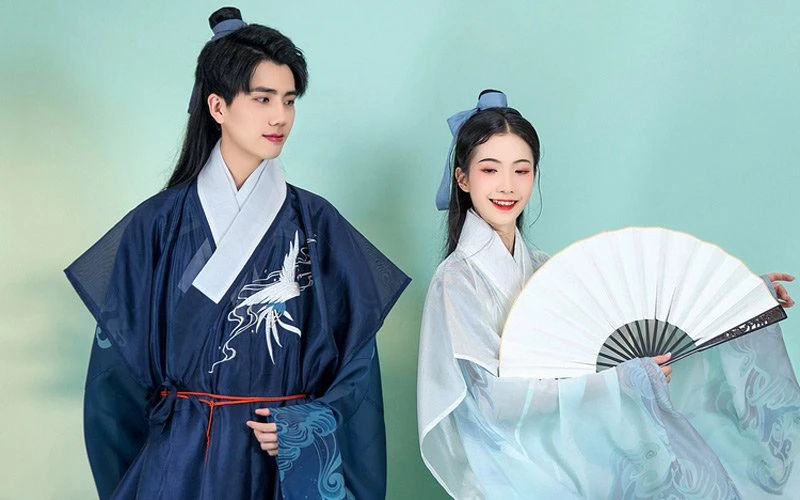

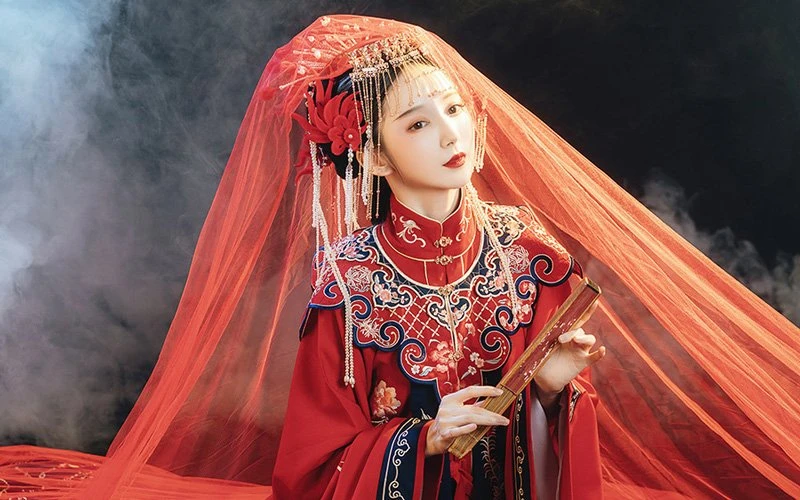
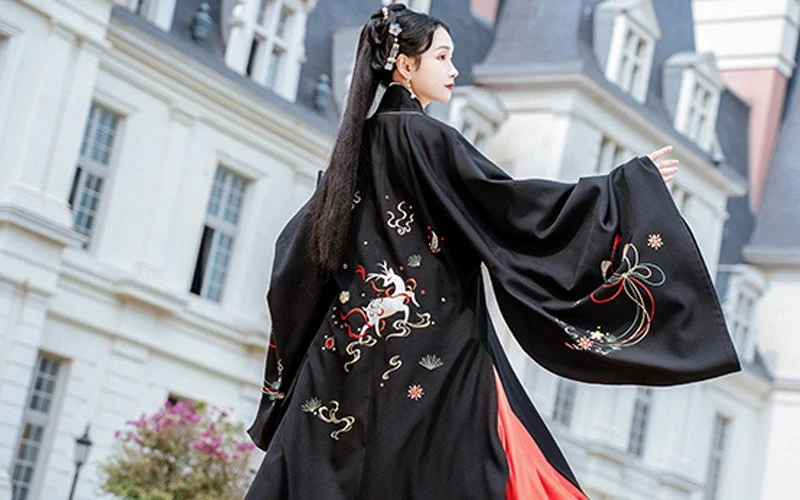
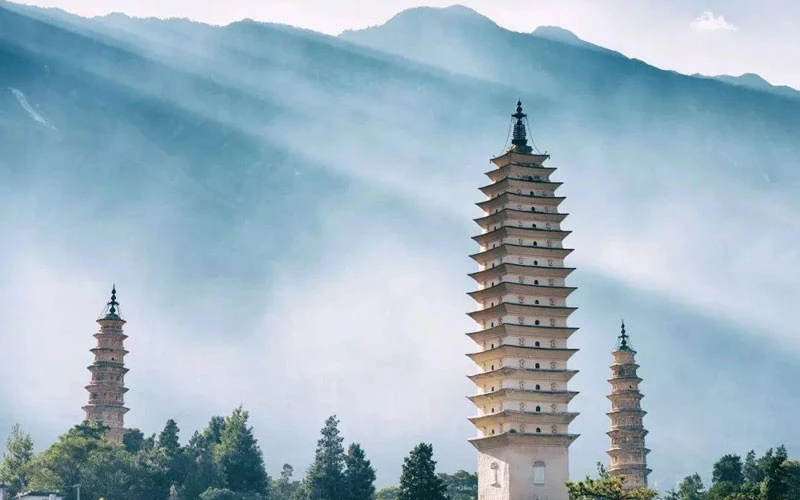
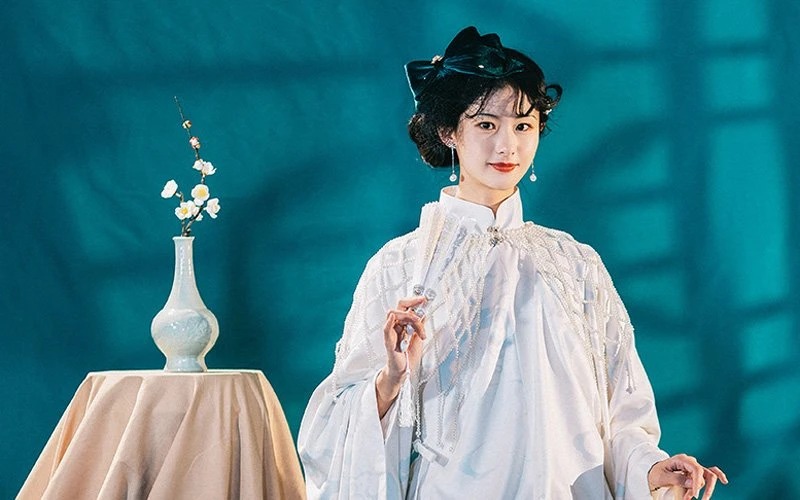
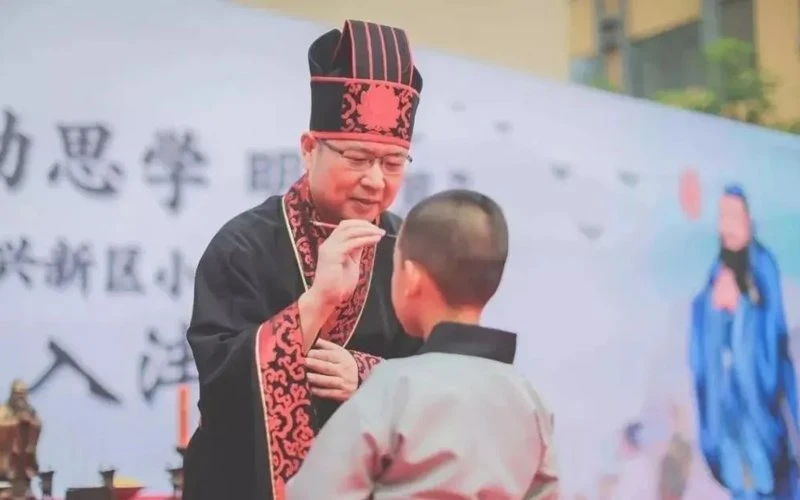


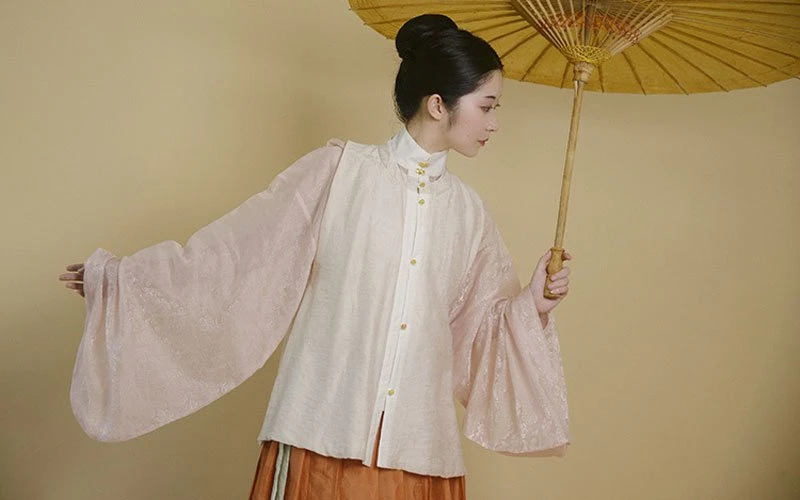
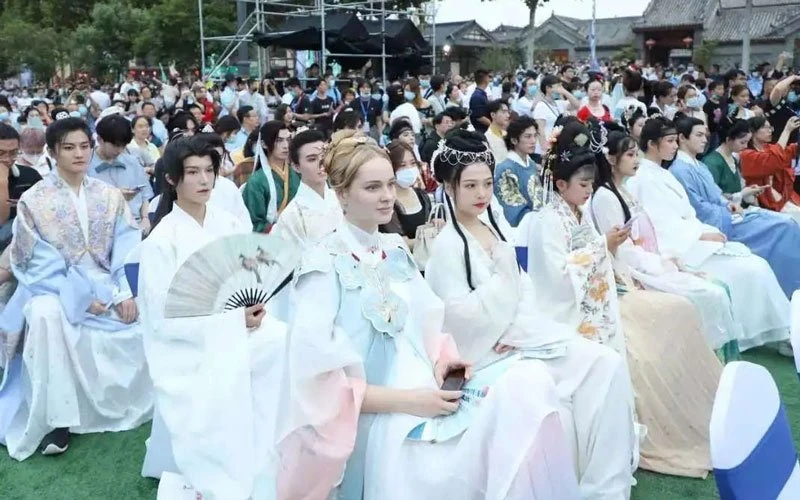
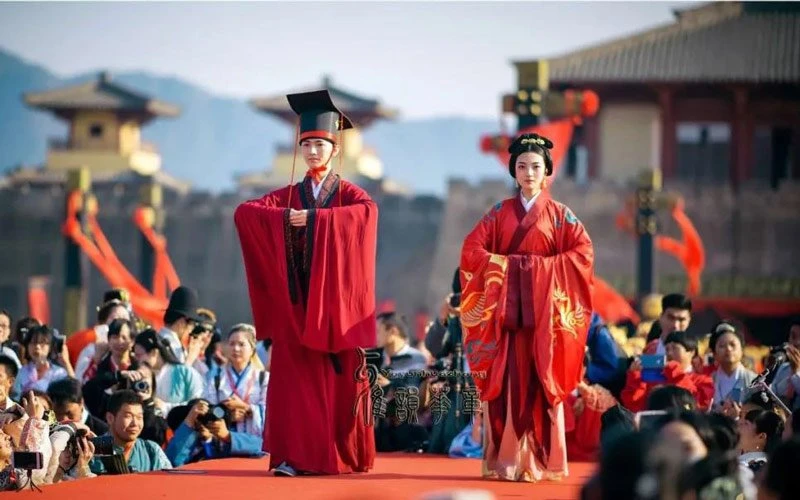
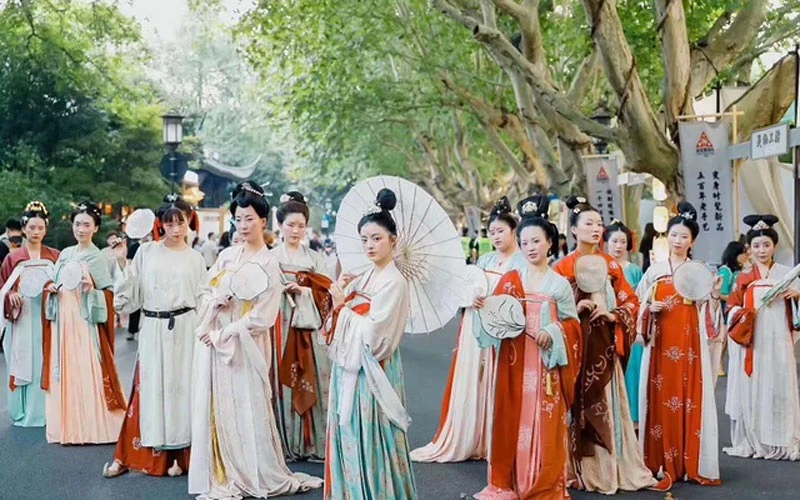
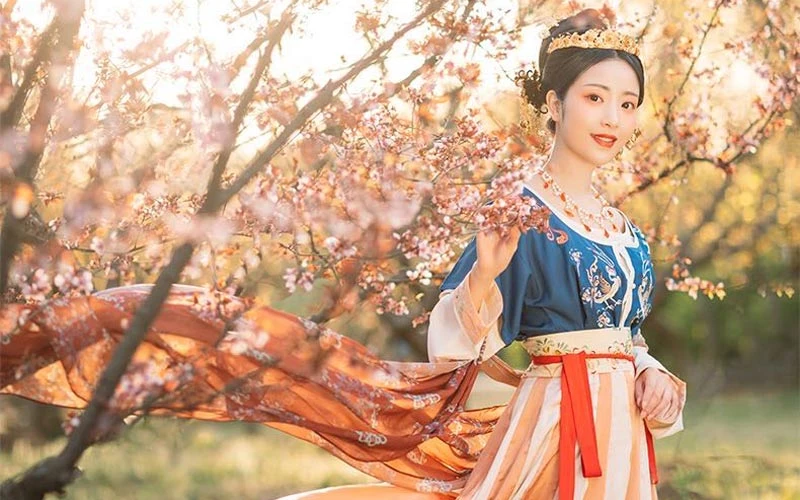
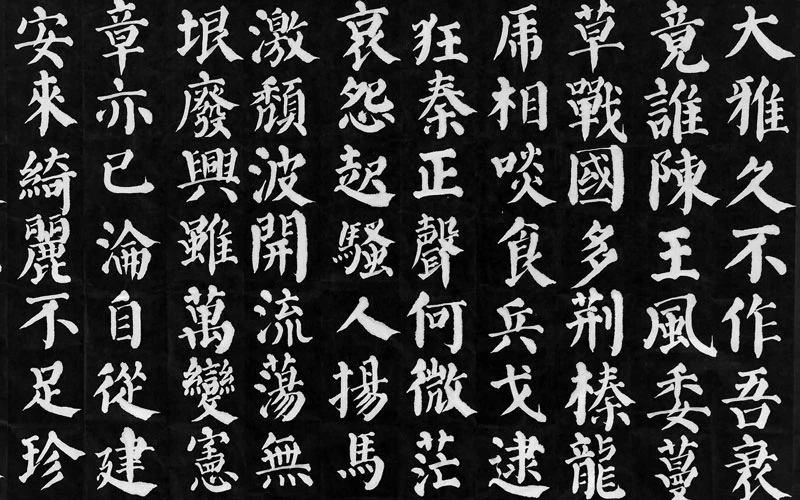
![History and Development of Chinese Kung Fu [Martial Arts]](https://www.newhanfu.com/wp-content/uploads/2021/07/History-and-Development-of-Chinese-Kung-Fu-Martial-Arts-0.jpg)

